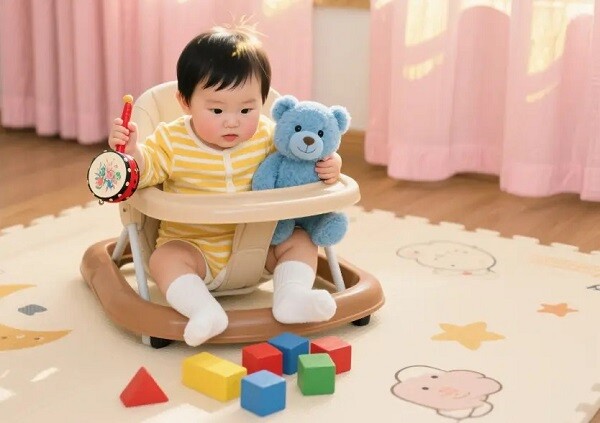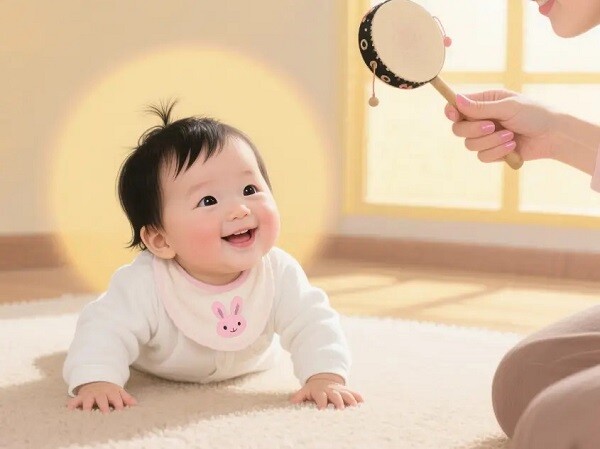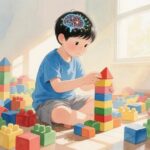A child’s brain development can indeed be observed through their daily movements and gestures. Simple actions such as waving, smiling, or even a curious gaze reflect progress in cognitive abilities.
Particularly, when a child exhibits the following three signs, it indicates healthy brain development, and it’s crucial for parents to nurture and encourage these behaviors appropriately.


Your Child’s Hands Are Always Busy
Children love to touch and explore everything with their tiny hands. They might throw or break toys, and sometimes put things in their mouths. While these actions can be frustrating for parents, seeing their child’s hands as a “second brain” can offer a new perspective.
Through these explorations, children are learning about the world around them. Repeating the same actions, like knocking down blocks or throwing toys, is their way of understanding cause and effect in a rudimentary way: if I push something, it falls; if I press a button, it makes a sound.
Although these actions may seem simple, they are essential for developing initial logical thinking skills. Each time a child performs an action, they are forming neural connections in their brain, fostering their thinking abilities.
Instead of scolding your child for making a mess, try to view it as an opportunity for them to explore and learn. Research suggests that these curious and active children often exhibit better learning and practical abilities in the future.
Embrace these moments as a crucial part of their growth and a fascinating journey of discovery, where they develop essential life skills and thinking capabilities.

Encourage your child’s curiosity and exploration.

Sensitive to Sensory Stimuli
When a baby is born, the “hardware” for their five senses is ready, but the “software” is not yet fully developed. This is particularly true for their sense of sight, as everything they see initially appears as a blurry outline, including their mother’s face.
However, don’t underestimate this phase. By two months, infants start to distinguish between black and white, and by three months, their color perception becomes clearer.
You’ll notice your baby starting to track moving objects with their eyes, even fixing their gaze on your face and smiling back at you. These reactions indicate healthy visual development and the beginnings of social interaction, signaling healthy brain development.
On the other hand, if a child isn’t making clear eye contact after a few months, doesn’t respond to teasing, or seems indifferent when called by name, it might be a sign that their brain’s sensory processing abilities aren’t developing fast enough and require more stimulation and engagement. Creating a rich environment with visuals and sounds can help accelerate this development.
Research suggests that infants with well-developed senses tend to be more intelligent, curious, and passionate about exploring the world. This curiosity will drive them to learn and gain experiences, giving them an advantage in language acquisition, memory building, and understanding their environment as they grow.
Therefore, it’s essential to support the development of your child’s senses and lay a strong foundation for their comprehensive development in the coming years.

Encourage sensory stimulation for healthy brain development.

Early Language Development
Language is one of the most complex human abilities, requiring the coordination of multiple brain regions.
Many parents believe that babies start babbling around 8 to 9 months old. However, as early as 3 to 4 months, infants enter the so-called “shouting stage,” suddenly producing sounds like “ah ah wu wu” and even shrieking with delight.
While this may sound unpleasant to adults, it’s actually the warm-up for their language system. Babies are exercising their vocal cords to produce different syllables, laying the foundation for future speech. Those who go through this stage earlier and more intensely tend to have better language organization skills.
For example, a baby might start self-talking at 5 months, babbling like singing. By 10 months, they may be able to clearly call out “Dad” and “Mom.”

Create a safe and encouraging environment for your child’s development.
Of course, speaking later doesn’t indicate any intellectual issues. To support language development, parents can talk, sing nursery rhymes, and read picture books to their children, stimulating their brain’s language centers.
Intelligence is not a fixed trait but something that can be nurtured over time. If your child exhibits these signs, it suggests that their brain is developing rapidly. However, these manifestations are not solely determined by genetics but also influenced by their family environment and education.
Remember, each child is unique, with their own pace of development. Some may flourish rapidly in their early years, while others take more time to explore and understand the world. The key is to provide a safe and encouraging environment, allowing them to reach their potential.
The Smart Kid’s Trifecta: Engage, Explore, Excel
“Early childhood stimulation has a profound impact on a child’s brain development. Research suggests that with adequate stimulation, the efficiency of neural connections can increase by up to 40%. This highlights the critical role of a child’s environment and experiences in their cognitive growth and overall brain health.”



































